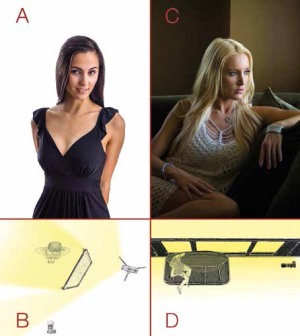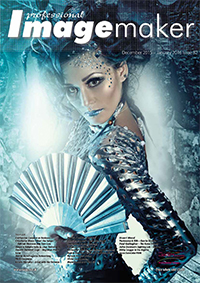articles/Lighting/lightp40-portrait-main-page1
Dave Montizambert's Creating With Light Part 40 - Portrait Main Placement - part 1 of 1 2 3
by Dave Montizambert Published 01/12/2015

Photographers have always cherished, drooled over, dreamed of, the north-facing natural-light studio with its beautiful soft wrap-around window-light. But we are into the 21st century with lots of available electricity to power artificial lighting, sowhy are we still so stuck on this idea of north-light? Is it reallyviable for a busy working studio? I don't think so. I believe that it is, inmost cases, a romantic idea; it plays on our yearning for nature and allthat is natural and it is plays on our weakness of something for nothing.But for a busy portrait or fashion/glamour studio it is just not practical.
It certainly was practical in the 17th century for studio portrait painters such as Rembrandt and Vermeer who were born a few centuries too early to take advantage of artificial lighting. During daylight hours it gave them fairly consistent light compared to light from the south since direct sunlight was always blocked by the walls and roof of their north facing studios - the north sky always provides a large light source, regardless of weather, so is ideal for creating soft-lit portraits. Now that I've possibly pissed you off for slagging north-light, take a look at Image 001 and Image 002, both are natural light north-lit images... or are they? Look closely... can you tell? One is window-lit with the north sky and the other is a mono-block strobe fired through a relatively large panel placed close to the subject in a windowless studio. If you don't believe me then look at lighting diagrams 003B and 003D then look at Image 003A of model, Sadie May, before I 'dropped-in' the art gallery background behind her).
My argument against north-light, which by the way I'm not really against, is that for a busy working studio it is somewhat limiting: limiting your choice of real estate, limiting usable angles you can shoot from, limiting time of day you can shoot because once the sun drops below the horizon you are done, limiting because brightness can change due to weather conditions, and limiting because you are stuck to a specific part of your studio space to be your shooting area. On the upside you don't have to buy any lighting equipment, set up time is greatly reduced, you have no strobe recycle time, and you can 'paint' yourself as a modern day Vermeer. So what is it about north-light that is so appealing? If you can figure that out then maybe you can recreate those attributes artificially. As far as I can figure, what we love about north-light studio lighting is its soft wrap-around-light quality. Soft wrap-around-light can only come from a relatively large and relatively close light sources. The sky, which compared to us is very large, may seem fairly far from our subjects we are trying to light, but on the large scale that it is on, it is not far away at all.
You are currently on page 1
- Dave Montizambert's Creating With Light Part 40 - Portrait Main Placement page 1
- Dave Montizambert's Creating With Light Part 40 - Portrait Main Placement page 2
- Dave Montizambert's Creating With Light Part 40 - Portrait Main Placement page 3
1st Published 01/12/2015
last update 09/12/2022 14:55:56
More Lighting Articles
There are 18 days to get ready for The Society of Photographers Convention and Trade Show at The Novotel London West, Hammersmith ...
which starts on Wednesday 14th January 2026





